Our stay in Mostar and Bosnia and Herzegovina had been exciting and a real learning experience but, on the morning of September 4th, we left on the morning bus for our next port of call, the Dalmatian coastal city of Split in Croatia.
Ivy: I thought of you as we were served figs at our final breakfast at Hostel Nina as I remembered eating my first one when we were shopping at Costco for Hanna's wedding. Figs grow everywhere in this region - you would love it here!
We had a 4.5 hour bus journey ahead of us so time for me to work on one of the posts until the laptop battery gave out, time to read more of a gripping David Baldacci novel and time to admire the stunning views as we drove along the Makarska Riviera south to Split. If the word 'riviera' conjures up thoughts about gorgeous blue green waters, sheer karst mountains, idyllic seaside bays, sun worshippers on picturesque beaches dotted along craggy coasts, images of sailboats, yachts and parasailers, inn after inn each advertising rooms for tourists, that is what we saw too.
Photos along the Riviera (please excuse the dirty bus window!):
Italy was just across the Adriatic from us as we drove along the coast.
From Split's bus station, located right in front of the bustling port, we took a taxi to our Airbnb.
When the taxi dropped us off in front of a very ugly, three story concrete apartment block that seemed like a long walk from downtown, I certainly had reservations about where I had chosen for us to stay. However, once inside I think Steven and I both felt we had died and gone to 'accommodation heaven' when we discovered the fabulous three room apartment that turned out to be about only a 15 minute walk from town. It had a living room with a balcony off it, a nice sized bedroom and eating area. More on the 'kitchen' later! We both said it would be great if we could just stay here for more than the three days we had reserved.
We thought we had hit the big time here when we noticed real sized bath towels on the bed. In the last several places we only had had towels slightly larger than hand towels to dry ourselves with. What luxury!
We had concerns initially that our airbnb was located a far stretch from downtown based on the taxi ride from the bus station but we discovered quickly that it was a very good location after all. Phew - I was relieved discovering that since I take responsibility for making 99% of our reservations.
On our way we passed by Trg Gaje Bulata (trg means square) and the grand Croatian National Theater whose facade was destroyed in a devastating fire in the 1970s.
In the same square was this rather austere building that we only noticed was a church when we stepped back from it, looked up and saw the spire.
At the end of the square and right by the water was the Franciscan monastery and Church of St. Francis according to maps.me and googlemaps on Steven's ipad. We didn't notice any sign either inside or outside the church listing its name.
Wreath was made of bay leaves:
The brightly colored and naif cross seemed very unusual considering the traditional style of the rest of the church.



Ivy: I thought of you as we were served figs at our final breakfast at Hostel Nina as I remembered eating my first one when we were shopping at Costco for Hanna's wedding. Figs grow everywhere in this region - you would love it here!
We had a 4.5 hour bus journey ahead of us so time for me to work on one of the posts until the laptop battery gave out, time to read more of a gripping David Baldacci novel and time to admire the stunning views as we drove along the Makarska Riviera south to Split. If the word 'riviera' conjures up thoughts about gorgeous blue green waters, sheer karst mountains, idyllic seaside bays, sun worshippers on picturesque beaches dotted along craggy coasts, images of sailboats, yachts and parasailers, inn after inn each advertising rooms for tourists, that is what we saw too.
Photos along the Riviera (please excuse the dirty bus window!):
Italy was just across the Adriatic from us as we drove along the coast.
From Split's bus station, located right in front of the bustling port, we took a taxi to our Airbnb.
When the taxi dropped us off in front of a very ugly, three story concrete apartment block that seemed like a long walk from downtown, I certainly had reservations about where I had chosen for us to stay. However, once inside I think Steven and I both felt we had died and gone to 'accommodation heaven' when we discovered the fabulous three room apartment that turned out to be about only a 15 minute walk from town. It had a living room with a balcony off it, a nice sized bedroom and eating area. More on the 'kitchen' later! We both said it would be great if we could just stay here for more than the three days we had reserved.
We thought we had hit the big time here when we noticed real sized bath towels on the bed. In the last several places we only had had towels slightly larger than hand towels to dry ourselves with. What luxury!
We couldn't wait to get out and explore Split since we still had a good chunk of the afternoon ahead of us. Since our apartment building was in a row of several others that all looked identical, it was handy having the local soccer team insignia painted on ours as a frame of reference so we'd know where to turn in once we returned later. Zachary: I looked high and low for a tshirt like this to buy for you but was unsuccessful - sorry, hon.
On our way we passed by Trg Gaje Bulata (trg means square) and the grand Croatian National Theater whose facade was destroyed in a devastating fire in the 1970s.
In the same square was this rather austere building that we only noticed was a church when we stepped back from it, looked up and saw the spire.
We continued strolling south back toward the sea and walked on the pedestrian-only Marmontova. Coming from Mostar where there had few indications of money and opportunities to spend money, this stretch of Split was a fashion nirvana. There were fancy designer shops up and down the polished promenade.
As Marmontova approached the sea, we escaped the crowds and turned right onto Trg Republike or Republic Square. It was amazing that this elongated square with its attractive colonnades and buildings and views toward the Adriatic lay forgotten with only the Bellevue Hotel at the end providing any life.
Wreath was made of bay leaves:
The brightly colored and naif cross seemed very unusual considering the traditional style of the rest of the church.
We walked along the Riva, the palm-fringed pedestrianized waterfront which was lined with crowded cafes, stalls selling tourist bric-a-brac, benches every few feet to rest one's weary bones or to simply admire the stunning views.
The focus of Split life focuses on Diocletian's Palace built on the waterfront by the Roman emperor Diocletian as a retirement home between AD 295 and 305. It was later inhabited by citizens of the neighboring Roman city of Salona after their homes were destroyed by invaders in the 7th century. Over the centuries. Split's citizens chose to build into and around the palace strucure rather than demolishing it so that now tourists can eat, drink and sleep in the footstreps of a Roman emperor!
More than 200 buildings remain inside the original dimensions: his old chambers and garrisons have been converted into shops, bars, cafes, hotels and homes as more than 3,000 people still live where refugees from nearby Salona originally moved in.
From the waterfront, we walked straight into Diocletian's Palace through the small Bronze Gate which used to be right on the water's edge and only accessible by boat.
The entrance was predictably lined with souvenir stalls.
As we entered, we saw the palace and the Old Town had been listed in 1979 as an UNESCO site.
The Bronze Gate entrance led us directly to a subterraneum museum with artifacts from Roman times laid out in the emperor's old living quarters.
Photos of the subterraneum museum:
As we walked from room to room through the veritable maze, we needed to keep a close eye on each other as each one had three other exits from it! There were very view descriptions to explain what we were seeing. These, though, were parts of stone water pipes from the ancient sewer system.
It was amazing how well everything was preserved or had been preserved. The high quality limestone came from the island of Brac`.
The interestingly shaped roof in one of the rooms:
A bust of Diocletian: He was born near Salona in AD 245, the son of a former slave and rose to become emperor after a distinguised career in the army. His retirement palace, which he began about halfway through his 21-year reign, was completed in AD 305, the year he abdicated - and the only Roman emperor to do so - and just six years before his death.
There was water dripping from the ceilings in some of the rooms which caused algae to grow on many walls.
All that remains of a sphinx sculpture that had been imported from Egypt. I didn't mind as I knew we'd be seeing more than we ever want when we head onto Egypt in about a month or so!
Pressure equipment for the production of olive oil:
This may look like a bathtub but it was a Sarcophagus! It may have been used for secondary purposes.
Wells that were discovered during excavations that took place between 1955 and 1965.
After being underground exploring the rooms, it was great getting above ground again and seeing the bright blue sky again.
Some steep steps brought us to the Peristyle, which looked like it came out directly from a Hollywood movie: a marvelous Roman set which featured a sunken square, a line of Roman columns and more Egyptian sculptures.
The sphinx below once guarded Diocletian's tomb:
What movie set would be complete without a wedding couple on the balustrade dancing to music blasting away? It was so neat it was almost comical.
In the middle of the Roman columns, there was the immense Cathedral of St. Dominus whose lofty bell tower was a later addition. Alexander: I think of you every time now when I include a number of photos of one sight like the cathedral here. Just skip over them, hon!
I found it fascinating to read that the structure is regarded
as the oldest Catholic cathedral in the world that has not been substantially
rebuilt at any time. What was added was a 12th-16th Romanesque bell tower and the 13th century choir inside.

I wish I had taken a better photo so you could see that the wooden panels in the entrance doorway from 1214 have
scenes from the Gospel.

This was the only panel I took a photo of:

It is somewhat ironic that the last resting
place of a man notorious for his persecution of Christians, and who was present
at the persecution at the beheading of St. Dominus, should have been converted
into a Catholic cathedral – albeit one of the world’s smallest.
The Cathedral may have been small but it was stunning.
Ornately decorated 13th century choir stalls:
First time seeing a candleabra looking like this:
More photos of the Peristyle:
We then walked down into the Cathedral's so very peaceful crypt which was accessible by another entrance:
Shrine and notes written to St. Lucia:
It was very gripping reading these heartfelt notes - I almost felt like a voyeur reading people's diaries.
After leaving the Cathedral, we had a blast wandering in and getting lost in the warren of very narrow passageways in the Old City. We had hoped to visit the Synagogue next but it was closed. Oh well, something to save for another day.
The entrance to the synagogue which was built in the early 16th century and, according to my travel notes, caters to a 100-strong member community.
It is located on aptly named Jewish Passage inside Diocletian’s Palace and is one of only a handful of synagogues still in existence in Croatia and the third oldest in continuous use in Europe.
Under Nazi occupation this street formed part of the Jewish
Ghetto but most Jews were interned on the nearby island
of Rab
We meandered over to Narodni Trg or People's Square next. This graceful space looked like it had been transported from a little corner of Venice onto the edge of Diocletian's Palace. In the 15th century, as the city expanded beyond the confines of the Palace, this square became the most important in the city.
One of the most important buildings on the square is the Town Hall which dominated the square. It was surrounded by several palaces which have been converted into hotels, bars and restaurants.
We had got there at the perfect time as a girls' dance/theater troupe began their performance.
Andrew: This photo of the cafe scene in the People's Square is for you. I hope it counts even though we weren't the ones sitting down enjoying coffee and watching the world go by?!
We were just entranced by all the medieval alleys as we hadn't seen anything like them so far this trip.
We left Diocletian's Palace by the Golden Gate which was far bigger than the Bronze Gate through which we had entered several hours previously. The Gate, which used to have a figure of Diocletian among other statues, had led to the Roman town of Salona.
I really enjoyed listening to this troubador who sang mostly folk songs in English but also in other languages as well.
Leaving the gate, it was impossible not to be struck by the massive Grgur
Ninski statue, the 9th century bishop who challenged Rome by advocating that the Croatian Church use the Slavic tongue rather than Latin. We saw many people rubbing the toe for
luck. The sculpture by famous Slovenian/Croatian sculptor Ivan Mestrovic, stood by the
Peristyle inside the palace complex until the Italian occupying authorities
moved it out, fearing its symbolic performance to Croatian national
consciousness.
The area around Split and in particular, the island of Hvar, is famous for lavender. As a result, it seemed like every shop we passed by had beautifully perfumed sachets of lavender, lavender oil, soap, etc for purchase. I only hope that the few items I bought will still smell as sweet when I bring them home in December!
Just outside the gate was the miniscule St. Martin ’s Chapel which was located in an old Roman guardhouse and probably built in the 5th or 6th century. The chapel was closed and one side of it was now entirely glass so it was tough to take photos of its interior.
As it was getting late, we decided to return to our apartment. I love this time of night to take photos as the setting sun casts a gorgeous light on the stone buildings.
If you look closely, you will see the spray of water from the fist on the brick wall into the massive urn below. We had no idea then of the significance of it.
From the stupid to the serene: At the beginning of this post, I remarked on our passing a building that only later did we realize was a church located by the National Theater. This is the inside of that same church. The doors were open as we walked by as Sunday evening mass was being celebrated. I stayed for a while while Steven rested his weary bones outside.
Our first few hours discovering peaceful Split were a lovely respite and we looked forward to enjoying more of the city and environs in the days ahead.
Posted from Kotor, Montenegro on September 13, 2016.













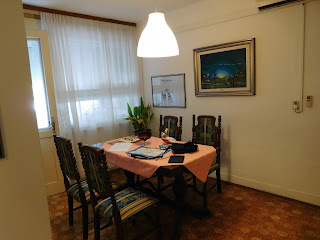

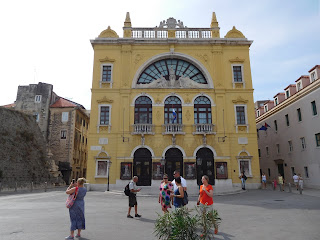





































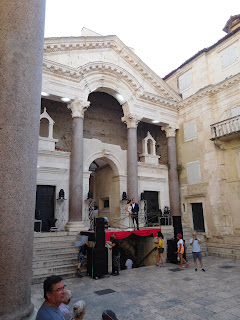





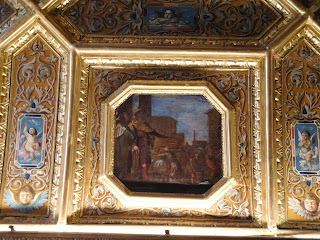



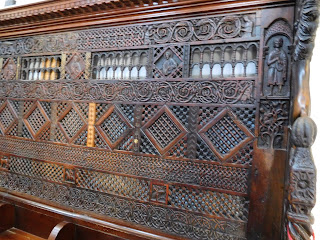





































No comments:
Post a Comment
We love to hear from you!!!!